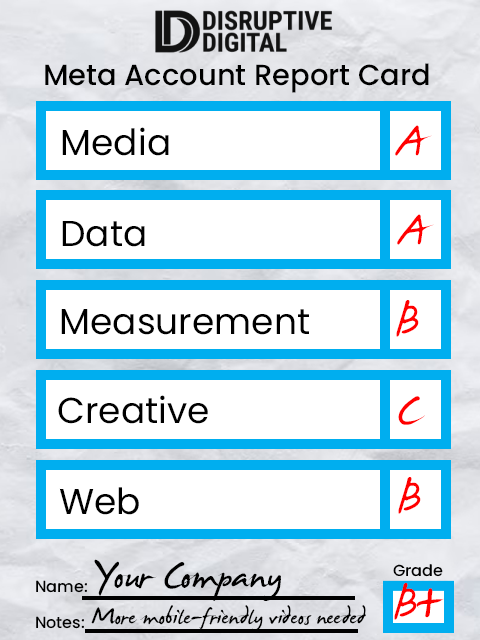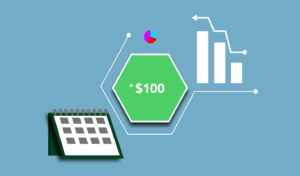Running ads on Meta network has the potential to bring immense ROI for your business. But that’s only if you get the setup right.
It’s almost impossible to create a modern digital strategy without at least considering Meta as part of your channel mix. The fact that it’s easy to set up at its surface only adds to its appeal.
And yet, it’s exactly that ease that can make running a successful Meta strategy difficult. As easy as it is to set up a campaign, it’s also simple to set it up wrong.
Fortunately, you can correct any mistake you make on the platform. Look for these 19 red flags suggesting issues with your Meta buying strategy, then make strategic adjustments to optimize your campaigns.
FREE GUIDE
Meta Account Report Card
Your path to success begins with the Meta Account Report Card, your key to unlocking unparalleled insights and maximizing your social media presence.
1. Using Multiple Ad Accounts
If you have multiple brands or billing mechanisms, or if you run parts of your campaigns through an external partner, it may seem easiest to set up your ad sets on multiple ad accounts. But, while you still likely won’t compete against yourself in the Meta auction, multiple ad accounts can easily lead to double-counted conversions, decreasing accuracy in your reporting and optimizations. It’s vital to stick with a single ad account.

2. High Numbers of Ad Sets
Too many ad sets can dilute your budget and decrease your optimization abilities. While the exact number of ad sets (both active and built in the last 30 days) depends on your exact campaign, look to keep them as focused as possible. That’s especially true when looking at ads still in the learning phase.
3. Overindexing for Ad Sets in the Learning Phase
The more ad sets you have in the learning phase, the less insights and optimization you’ll gain from each of them. Optimally, you should have one ad set at most in this phase, with a spend below 20%.
In fact, advertisers with only 20% of their spend dedicated to learning phase ad sets see a 17% increase in conversions, along with a 15% decrease in cost per acquisition, compared to advertisers who spend 80% of their budget on these ads.
4. Underfunding Your Ad Sets
To achieve optimal results from your ad sets, it’s crucial to allocate an adequate budget. This ensures your ads exit the learning phase and gather enough data to optimize performance. Here’s a straightforward way to determine your minimum budget:
-
- Identify Your Cost Per Acquisition (CPA): This is how much it costs you, on average, to acquire a conversion (e.g., a sale or a lead).
- Calculate Your Weekly Conversion Goal: To exit the learning phase effectively, aim for at least 50 conversions per week.
- Use the Formula: Multiply your CPA by 50 (the number of conversions you aim for) and then divide by 7 (the number of days in a week).
Formula: Minimum Daily Budget=(CPA×50)/7
Example Calculation:
Let’s say your CPA (Cost Per Acquisition) is $10.
-
- Multiply your CPA by 50: $10 * 50 = $500. This is your weekly budget to achieve 50 conversions.
- Divide by 7 to find your daily budget: $500 / 7 ≈ $71.43.
So, to optimally fund your ad set and support it in exiting the learning phase, you should allocate at least $71.43 per day. This calculation helps ensure that no single ad set running on your account is underfunded, allowing for more effective learning and optimization.

5. Spending Across Multiple Funnel Levels
It’s tempting to use your Meta ads as a way to drive your audience through the entire funnel. But in reality, a consolidated funnel means more signal and better performance. When possible, focus on a single stage of your funnel, whether that’s prospecting, re-engagement, or retargeting. If you don’t, you may start to count and optimize for non-incremental conversions that don’t actually add value to your business.
6. Optimizing Your Budget for Ad Sets, Not Campaigns
Rather than spreading your budget for individual ad sets (ABO), always aim for campaign budget optimization (CBO). This type of optimization performs better because it distributes your funds in real-time to the ad sets with the best possible opportunities, leading to better performance over the life of your campaign.
7. Not Using Advantage+ Campaigns
If you sell directly through Meta, Advantage+ campaigns are among your most powerful options on the platform. According to our analysis across accounts, Advantage+ Shopping campaigns drove a 17% cost per conversion and 32% increase in ROAS, while Advantage+ App campagins drove a 26% CPA improvement. Depending on on your business, look to have at least one of these set up and running at all times.
8. Ambiguous Naming Conventions
Pay special attention to the way you name your campaigns. If you don’t, you might run into difficulties when it comes to analyzing your different campaigns, ad sets, and ads. Keep your names straightforward and consistent to both save time and increase accuracy in your reporting.
9. Overcomplicated Attribution Settings
Speaking of being straightforward: it pays to keep your attribution setting as simple as possible. Unless you’ve calibrated your campaigns for incrementality, a attribution setting for 7-day click and 1-day view attributions lowers CPM and CPA.

10. Attribution Below the Purchase Level
Naturally, attribution should also reach as far into your conversion journey as possible. Only optimizing your campaigns for the primary goal event, typically the purchase or app download, leads to true optimization. In fact, advertisers leveraging conversion optimization drove a median 71% lower cost per purchase than campaigns optimized for link clicks.
11. Non-Separated Concept Testing Campaigns
Testing new campaigns and concepts is a great idea. But it only works if you can clearly track how those specific campaigns and ad sets are performing. Always set up concept testing ads and campaigns separately, which helps your new campaigns find winning ads while also preventing high-performing campaigns from resetting into the learning phase.
12. Fully Automated Bidding Strategy
Automated bidding is not always a bad thing. However, manual bidding can sometimes be the better option to help your efficiency by allowing your CPA to stay at or below a certain amount regardless of market conditions. If you do build manual bidding campagins, make sure you understand how to manage your ad spend to keep costs reasonable.
13. No Exclusions Set Up in Your Targeting
Never target indiscriminately. Setting up exclusions across your ad sets can reduce your media waste by sorting out irrelevant audiences, while also increasing incrementality. You’ll especially want to make sure that your existing customers are uniformly excluded from all campaigns not specifically targeted at renewal or repurchase.
FREE GUIDE
Meta Account Report Card
Your path to success begins with the Meta Account Report Card, your key to unlocking unparalleled insights and maximizing your social media presence.
14. Narrow or Interest-Based Targeting
Broad ad sets drive 16% better CPAs than fragmented ads. A broader target allows your campaign to self-optimize better and find more relevant audiences over time. Avoid target fragmenting, including vague metrics like interest-based targeting that might not rely on accurate data.
15. Indiscriminate Lookalike Audiences
Generally speaking, lookalike targeting can be a powerful tool to reach audiences similar to your current customers. At the same time, this targeting strategy can also become problematic because shared characteristics may not be visible or obvious to Meta.
In other words, this is not a set-and-forget ad targeting strategy. Set them up specifically ased on your business goals and value, ensuring that the resulting audience is actually relevant and likely to take the steps and bring the ROAS you need.
16. Overinvestment in Retargeting Campaigns
Retargeting is a dangerous strategy because its conversions are not necessarily reliable. Your retargeting ads may drive results on the surface but too often, those results are non-incremental—they would have occured regardless of the retargeting message getting in front of your audience.
It’s still a valuable strategy to increase brand recall, but you cannot overinvest in it. Aim for retargeting ads to take up less than 20% of your ad spend over the last 30 days and 90 days, while also keeping your audience sizes at 100,000 or above. For Advantage+ Shopping campaigns (ASC), cap your budget for existing customers below 15%.
17. No UTM Validation of In-Platform Reports
Meta offers some great reporting tools for your ads, but they’re not always reliable. Getting a second opinion through your own analytics tools is almost always beneficial, but you do need to set up your ads the right way to make that happen. Use consistent UTM tracking codes for all links so you can gut-check your campaigns’s performance outside of your ad platforms of choice at any point.
18. No Post IDs to Track Ads Across Sets and Campaigns
Speaking of tracking: especially when running ads with social proof, you don’t want to lose the power of your users and customers when those ads carry across campaigns and ad sets. Use Post IDs to ensure that doesn’t happen, building more consistent credibility for end-users while leading to lower CPMs in the auction.
19. Impression Frequencies Above Recommended Thresholds
Finally, keep a close eye on how often Meta serves your ads to your customers. Higher frequencies over shorter periods of time can be a signal of budget waste or audiences that are too small for reliable optimization and results.
Impression frequencies for both your account and ads should be below 8 for the last 30 days, and below 3 for the last seven days. Ideally, no ad sets should surpass that frequency for either the seven day or the thirty-day threshold in order to optimize your budgets.
Audit Your Meta Setup and Take Action on Red Flags to Improve Your Ad Performance
Meta campaigns may not be as simple as an initial setup suggests, but they still have the potential to drive immense success for your business. You just have to get them right.
Fortunately, a few central best practices can help you get there. These best practices are based on running high-volume campaign for clients across industries, and based on years of experience working directly for Facebook.
Work with us to audit your Meta buying strategy. Then, take the action steps you need to drive reliable ROI through each of your campaigns.






